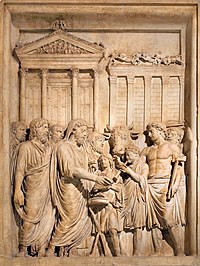
Photo from wikipedia
Dogmatic and oft-repeated interpretations of Roman antiquity are of late experiencing a round of needed reassessment. Some of these paradigmatic readings are so common that they are simply accepted as… Click to show full abstract
Dogmatic and oft-repeated interpretations of Roman antiquity are of late experiencing a round of needed reassessment. Some of these paradigmatic readings are so common that they are simply accepted as immutable, universal facts. Lisa Marie Mignone does Roman studies a great service by challenging one such dogmatic reading of the Republican city of Rome, namely the characterization of the Aventine Hill as a ‘plebeian district’. Mignone’s bold book aims to assess the evidence and thought processes that led to the characterization of the Aventine as a working-class neighbourhood, as well as to attempt to contextualize the reading of the Aventine better in both modern socio-political ideation and current scholarship. Mignone’s investigation of the Aventine and its characterization begins by confronting the standard treatise on the southernmost of Rome’s hills (Merlin 1906). The argument that proceeds from there is largely negative, in that the author aims to disprove Merlin’s reading of the Aventine by assembling a range of evidence that demonstrates that the idea of an urban district that is strictly segregated in socio-economic terms is not tenable. Mignone introduces the Aventine Hill (pp. 3–6) in order to situate it topographically with respect to the city of Rome. The introduction also gives the reader a preview of topics on which the author will expand further, namely the nature of the ‘plebeian Aventine’ construct (pp. 6–10) and the problematic issue of using the term plebeian to describe a district of an urban centre (pp. 11–13). If the Aventine is known in the popular consciousness, it is likely due to its long connection to the so-called ‘secession of the plebs’ (secessio plebis), a political phenomenon of the fifth through third centuries bc that might be described as a general strike of sorts, in which the working-class Romans quit the city en masse, leaving aristocratic patricians to their own devices. In carrying out these secessions, the plebeians sought better conditions for themselves, including better legal terms for the plebeians and access to magistracies (p. 17). In chapter 1, Mignone examines the secessions themselves from a literary point of view. The spatial dynamics of these secessions represent a key aspect of this discussion, since the plebs were thought to physically quit the city (urbs) of Rome and go elsewhere. Where, in fact, they went proves to be critical to Mignone’s discussion of the nature of the Aventine. The first secession (in 494 bc) has the plebs removing to theMons Sacer [Sacred Mountain], returning only after an aristocrat named Menenius Agrippa negotiates with the patricians on their behalf. The most likely location of theMons Sacer is a hill along the course of the Anio river, some three miles from the centre of Rome. While most of the textual sources situate this event on that hill, other versions—notably that of Piso—locate these events on the Aventine Hill (p. 21). This seems to be a mistake, but one that nonetheless has had its implications. The second secession (449 bc) saw the plebs quit Rome and march to the Mons Sacer, only then to march through the city again en route to the Aventine Hill, thereby occupying it. Mignone reminds the reader that the first-century bc readership of the historian Livy’s telling of this event would be quite familiar with the martial history of the Porta Collina, through which the plebs would have marched on their way to the Aventine (pp. 29–30). With the resolution of the second secession, the reintegration of the plebs into Roman society is significant and brings about a strong connection between the plebs and the Aventine itself, at least within theminds of ancient authors (p. 32). This strong link does not survive close analysis, however, as it seems that much stronger associations could be drawn between plebeian secession and other hills—namely the Mons Sacer and the Janiculum Hill (p. 35). Mignone even allows that, given available sources, historians may have played a role in overemphasizing the plebeian nature of the Aventine (p. 38) and that ancient authors like Livy himself may have been aware that it was Piso who authored the myth of plebeian secession to the Aventine (p. 43). Since Late Republican authors provide the textual accounts of earlier Republican history, it is of interest that their awareness of contemporary events also colours their interpretation of the past. For instance, the flight of Gaius Gracchus to the Aventine in 121 bc represents a significant event in the tradition of the Aventine as a landscape of resistance, since it occurs closer to the time of late Republican historians like Livy. The second chapter focuses on the Lex Icilia de Aventino, a Roman law of 456 bc. This law, promulgated by one Lucius Icilius, aimed to create land parcels on the Aventine that were assigned to plebeians, at least according to the ancient sources. This narrative, preserved in the text of Dionysius of Halicarnassus, is central to the notion of a plebeian Aventine (p. 51). Mignone analyses this law in the context of Roman land confiscation and later Republican laws. The fifth-century bc law and its details may well CAJ 28:2, 349–350 C © 2017 McDonald Institute for Archaeological Research